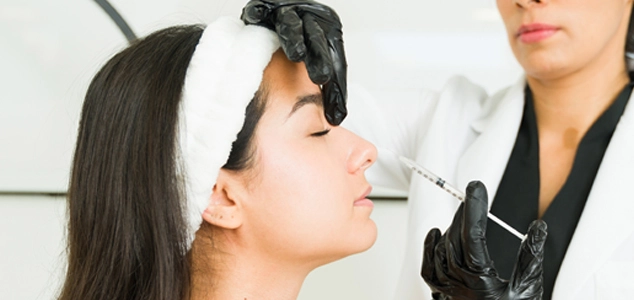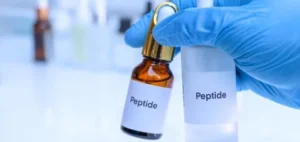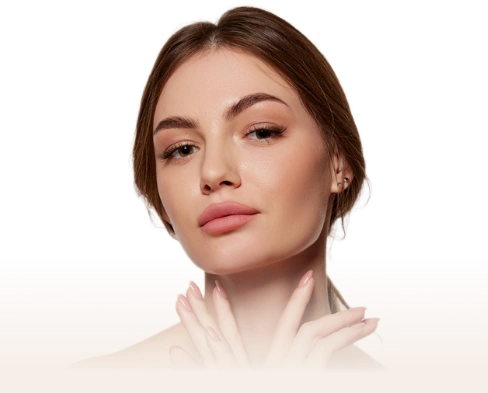Non-surgical rhinoplasty has appeared as a popular cosmetic procedure, offering a non-invasive way to reshape and enhance nasal contours. In this blog, we’ll explore the best nose fillers such as Juvederm, Restylane, and more, highlighting their effectiveness in addressing different aesthetic concerns. Discover the average prices associated with each filler and learn about their longevity to make an informed decision.
What Is Non-Surgical Rhinoplasty?
Non-surgical rhinoplasty, also known as a liquid nose job, is a cosmetic procedure that uses injectable fillers to alter and shape the nose. This minimally invasive technique can smooth out bumps, lift the nasal tip, improve symmetry, and enhance overall facial harmony. It’s a quick procedure with minimal downtime, making it an attractive option for many individuals.
What Is The Best Filler For a Non-Surgical Nose Job?
Several fillers are commonly used for non-surgical rhinoplasty. The choice of filler depends on the desired outcome and the specific needs of the patient. The most famous and widely used fillers globally include Juvederm, Restylane, Sculptra, and Versa.
Juvederm
Juvederm is one of the most popular fillers used for non-surgical rhinoplasty. It is a hyaluronic acid-based filler known for its smooth consistency and natural-looking results.
What Type of Juvederm is Best for the Nose?
Juvederm Voluma is considered the best option for non-surgical nose jobs due to its thicker consistency and longer-lasting results. However, Juvederm is excellent for nose filler. It provides a smooth finish, integrates well with the natural tissue, and has a high satisfaction rate among patients. The average cost of Juvederm for a non-surgical nose job ranges from $600 to $1,500 per syringe.
Restylane
Restylane is another hyaluronic acid-based filler frequently used for non-surgical rhinoplasty. It offers a versatile solution for various nasal issues. Restylane Lyft is often recommended for non-surgical rhinoplasty. It is known for its lifting capabilities and long-lasting results, making it a preferred choice among doctors. The average cost of Restylane for a non-surgical nose job ranges from $500 to $1,200 per syringe.
Radiesse
Radiesse is a calcium hydroxylapatite-based filler that provides immediate volume and stimulates collagen production for longer-lasting results. The average cost of Radiesse for a non-surgical nose job is between $600 and $1,200 per syringe.
Bellafill
Bellafill is a semi-permanent filler made of polymethylmethacrylate (PMMA) microspheres suspended in collagen gel. It offers long-lasting results, making it an appealing option for some patients. The average cost of Bellafill for a non-surgical nose job ranges from $1,000 to $1,500 per syringe.
Silicone
Silicone fillers provide permanent results but come with higher risks and potential complications. It is less commonly recommended due to these concerns. The average cost of silicone fillers for a non-surgical nose job is between $1,500 and $3,000 per session.
How Much Filler for a Non-Surgical Nose Job?
The amount of filler required for a non-surgical nose job varies based on the individual’s nasal structure and the desired outcome. Typically, 1 to 2 syringes of filler are sufficient to achieve the desired results.
Permanent Fillers vs. Temporary Fillers: Pros and Cons
When considering a non-surgical nose job, one of the critical decisions is whether to use permanent or temporary fillers. Each type has its unique advantages and disadvantages. Understanding these can help you make an informed choice that aligns with your aesthetic goals and lifestyle.
Pros of Temporary Fillers
- Reversible
- Safety
- Adjustability
- Less Commitment
Cons of Temporary Fillers
- Maintenance
- Cost Over Time
Pros of Permanent Fillers
- Longevity
- Cost-Effective in the Long Run
Cons for Permanent Fillers
- Irreversible
- Higher Risk of Complications
- Less Flexibility
Pros of Non-Surgical Rhinoplast
- Minimal Downtime
- Less Painful
- Immediate Results
- Non-Permanent
Cons of Non-Surgical Rhinoplasty
- Temporary Results (for Temporary Fillers)
- Limited Scope
- Potential for Complications
What Nose Issues are Best Solved by Non-Surgical Rhinoplasty?
Non-surgical rhinoplasty is ideal for addressing minor nasal asymmetry, smoothing dorsal humps or bumps, lifting a drooping nasal tip, and enhancing nasal bridge height. It is not suitable for major structural changes or significant size reduction.
Nose Filler Risks and Side Effects
Non-surgical rhinoplasty, while generally safe, carries potential risks and side effects. Common issues of facial cosmetic surgery include swelling, bruising, redness, and mild pain at the injection site, which typically resolves within a few days. More serious complications, such as infection, vascular complications, and filler migration, are rare but require immediate medical attention.
Long-term risks include granulomas and asymmetry, and extremely rare cases may lead to blindness or skin necrosis. However, if the previous surgical rhinoplasty didn’t provide the ideal results, the flaws can be improved with dermal fillers. Choosing a qualified practitioner, who is well-versed with the nasal anatomy and following pre- and post-care instructions can significantly minimize these risks.
Best Nose Filler Comparison
When it comes to non-surgical rhinoplasty, choosing the right filler is essential for achieving the desired results. Here, we compare some of the most popular fillers used for nose enhancement, focusing on their longevity, composition, and suitability for different nasal issues.
| Filler Type | Longevity | Cost Range (per syringe) | Suitability | Advantages | Considerations |
| Hyaluronic Acid (e.g., Juvederm, Restylane) | 6-18 months | $500 – $1,500 | Reshaping nasal contours Filling in depressions Refining nasal tip | – Reversible – Minimal risk of complications – Natural-looking results | – Temporary – May require touch-ups |
| Calcium Hydroxylapatite (e.g., Radiesse) | 12-18 months | $600 – $1,200 | – Correcting nasal asymmetry – Enhancing projection | – Stimulates collagen production – Immediate volume enhancement | – Not reversible – May cause temporary swelling |
| Poly-L-Lactic Acid (e.g., Sculptra) | Up to 2 years | $800 – $1,500 | – Adding volume to nasal areas lacking definition – Gradual improvement over time | – Stimulates collagen production – Long-lasting results | – Requires multiple sessions – Gradual onset of results |
| Polymethyl Methacrylate (e.g., Bellafill) | Semi-permanent | $800 – $2,000 | – Long-term volume enhancement – Structural support | – Provides immediate and lasting results – Minimal touch-ups | – Not reversible – Potential for granulomas or lumps |
| Silicone | Permanent | $1,500 – $3,000 | – Permanent augmentation – Often used in Asian rhinoplasty | – Permanent results – Minimal need for touch-ups | – Not reversible – Risk of migration or complications |
Type: Hyaluronic Acid
Longevity: 6 to 18 months
Cost: $500 to $1,500 per syringe
Best For: Smoothing bumps, lifting the nasal tip, improving symmetry
Advantages:
– Provides smooth, natural-looking results
– Reversible with hyaluronidase
– High patient satisfaction
Drawbacks:
– Requires maintenance treatments every 6 to 18 months
Type: Hyaluronic Acid
Longevity: 6 to 12 months
Cost: $500 to $1,200 per syringe
Best For: reshaping nasal contours, filling in depression, refining the nasal tip
Advantages:
– minimal risk of complications
– Reversible with hyaluronidase
– Good lifting capabilities
Drawbacks:
– Temporary, may require touch-ups
Radiesse
Type: Calcium Hydroxylapatite
Longevity: 12 to 18 months
Cost: $600 to $1,200 per syringe
Best For: correcting nasal asymmetry and enhancing projection
Advantages:
Stimulates collagen production
Immediate volume enhancement
Drawbacks:
– Not reversible
– May require more precise placement by an experienced injector
Bellafill
Type: Polymethyl Methacrylate (PMMA)
Longevity: Semi-Permanent
Cost: $800 – $2000 per syringe
Best For: long-term volume enhancement and structural support
Advantages:
– Provides immediate and lasting results
– Minimal Touch Ups
Drawbacks:
– Nonreversible
– Potential for granulomas for lumps
Silicone
Type: Silicone
Longevity: Permanent
Cost: $1500 to $3,000 per session
Best For: Permanent augmentation, often used in Asian Rhinoplasty
Advantages:
– Permanent results, minimal need for touch-ups
Drawbacks:
– Not reversible
– Risk of migration or complications
What Filler is Used in the Nose?
Common fillers used in non-surgical nose jobs include hyaluronic acid fillers like Juvederm and Restylane, calcium hydroxylapatite fillers like Radiesse, and polymethyl methacrylate fillers like Bellafill.
What is a Permanent Nose Filler?
Permanent nose fillers, such as Bellafill and silicone, offer long-lasting results. However, they come with higher risks and require a highly experienced injector to ensure safety and desired outcomes.
Nose Fillers Gone Wrong
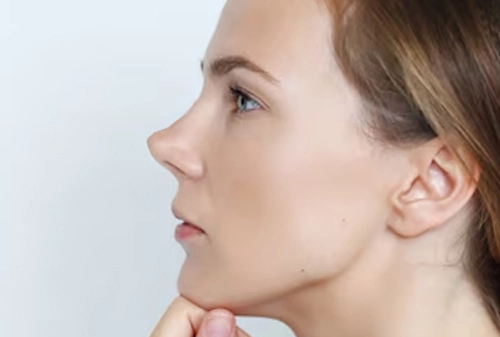
Nose Filler Before and After
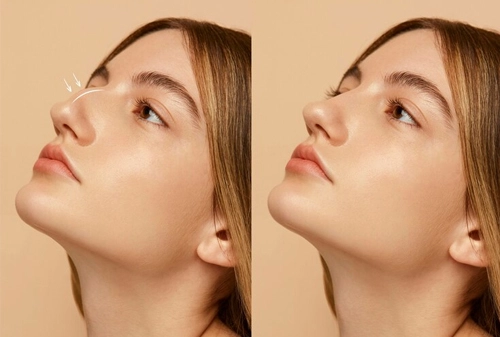
How Much Does a Non-Surgical Nose Job Cost?
The average cost of a non-surgical nose reshaping in the New York City ranges from $500 to $1,500 per syringe. Factors influencing the cost include the type of filler used, the clinic’s location, and the injector’s expertise.
Where to Get the Best Non-Surgical Nose Job in Manhattan, NYC?
For ated nontop-r-surgical liquid rhinoplasty in NYC, consider renowned practitioners such as Dr. Syra in Manhattan, known for her expertise and high patient satisfaction rates. Additionally, numerous med spas in Manhattan offer aesthetics services, with many top-rated options such as botox nyc available.
Frequently Asked Questions
Q1. What is a nose filler?
The nose fillers are injectable substances, typically hyaluronic acid-based fillers used in non-surgical rhinoplasty to reshape and enhance the nose’s appearance.
Q2. What filler lifts the nasal tip?
Juvederm Voluma and Restylane Lyft are commonly used to lift the nasal tip due to their thick consistency and strong lifting capabilities.
Q3. Where not to inject filler in the nose?
Avoid injecting fillers into blood vessels or areas close to the eyes to prevent serious complications like vascular occlusion or blindness.
Q4. Is nose filler dangerous?
While generally safe when performed by a qualified professional, nose facial fillers carry risks such as infection, vascular complications, and tissue necrosis.
Q5. What are the best nose fillers (Suggested) for a wide nose?
Restylane Lyft and Juvederm Voluma are recommended for contouring and narrowing a wide nose due to their lifting and shaping properties.
Q6. How dangerous is a non-surgical nose job with filler?
Non-surgical rhinoplasty procedure with filler has a low risk when performed by experienced practitioners, but complications like infection, asymmetry, and vascular issues can occur.
Q7. Do nose dermal fillers hurt?
Nose dermal filler injections can cause mild discomfort, but most practitioners use topical anesthetics to minimize pain during the procedure.

About The Author
Dr. Syra Hanif M.D.
Board Certified Primary Care Physician
Dr. Hanif is the Director of Aesthetic Medicine. She is a board-certified physician in Aesthetic Medicine who specializes in using non-surgical alternatives in order to enhance one's appearance through Botox and fillers.
Read More




